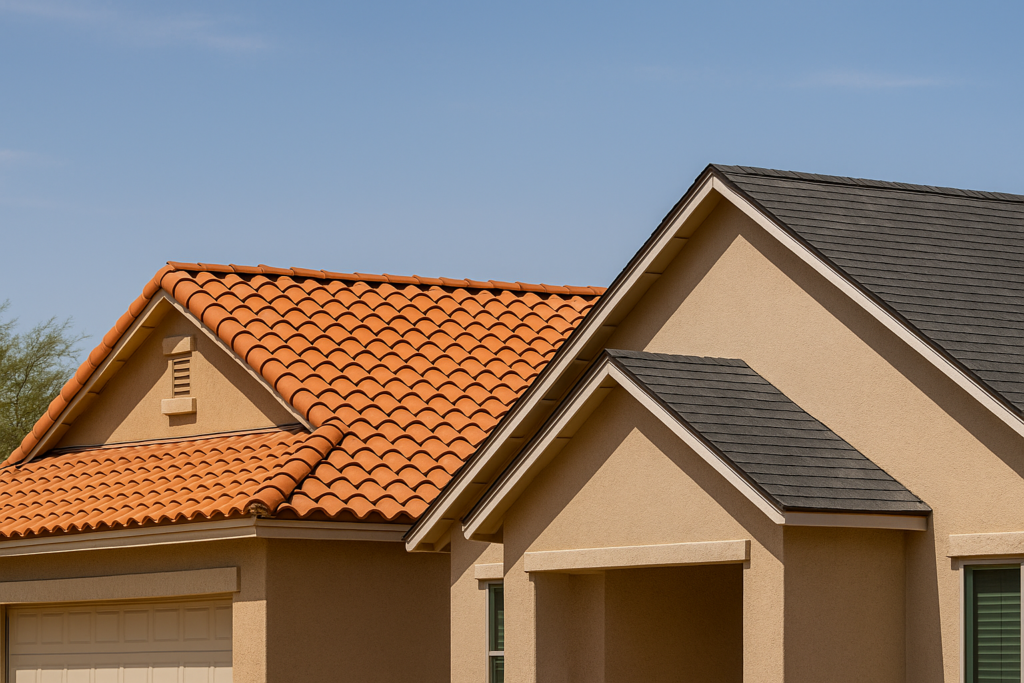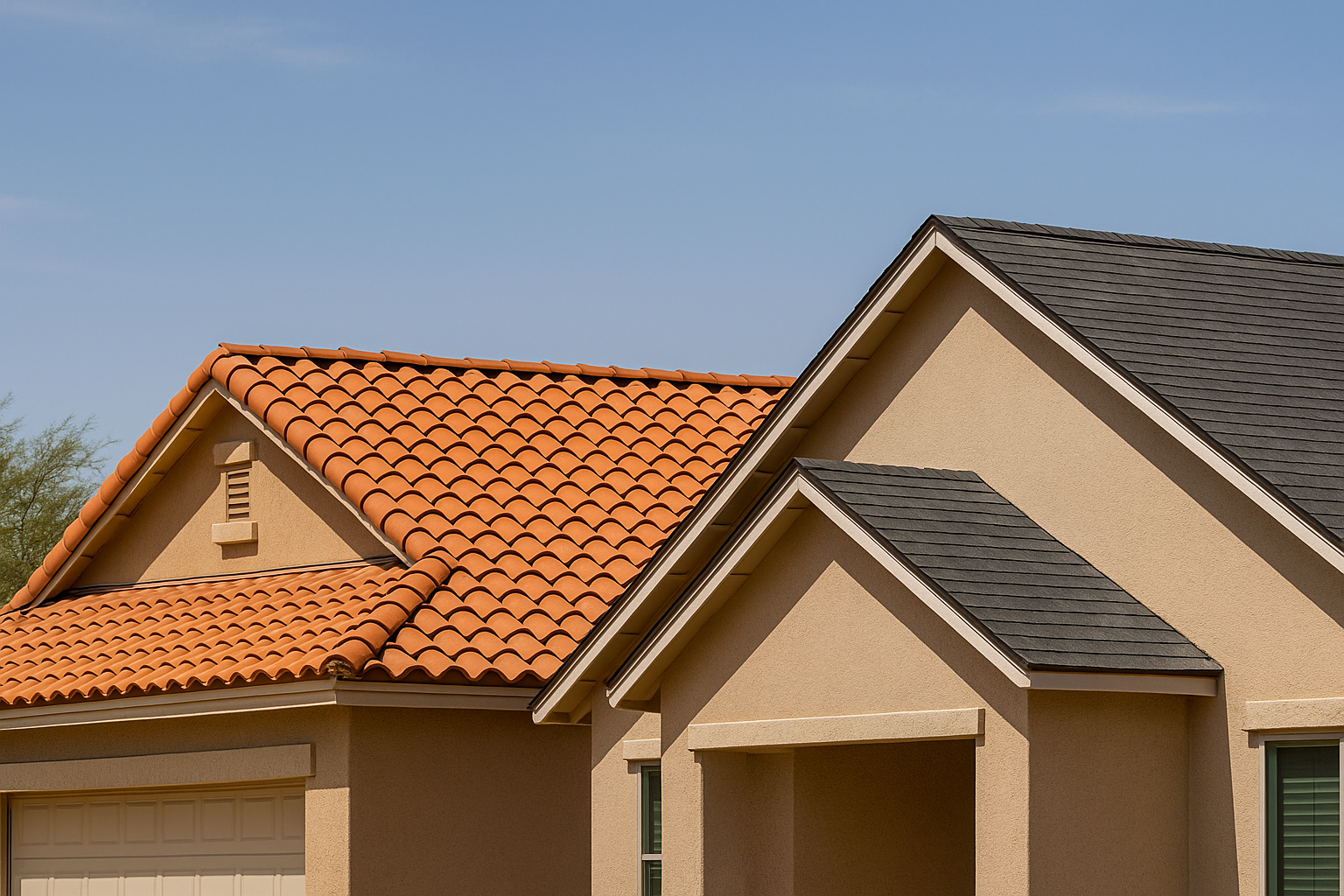
The Desert Isn’t Easy on Roofs
Between Arizona’s triple-digit summers and Utah’s icy winters, homeowners face a serious test of endurance—especially when it comes to their roofs.
The roof you choose determines how well your home handles extreme heat, sudden storms, and constant UV exposure. Two materials dominate the desert roofing scene: tile and asphalt shingles.
But which one is truly better for your home? The answer depends on your climate, budget, and long-term goals. Here’s a full breakdown from the experts at Baker Roofing Pros to help you decide.
1. Durability: The Lifespan Showdown
If longevity is your top priority, tile roofing is the clear winner. A properly installed tile roof can last 50 to 100 years, while a shingle roof typically lasts 20 to 30 years—less in intense sunlight or high-wind conditions.
Tile Roofs
- Resist cracking, rotting, and UV damage
- Maintain their color for decades
- Handle heavy wind and hail better than most materials
Shingle Roofs
- Easier and cheaper to replace
- Perform well in moderate climates
- Require more maintenance in high heat
In desert climates, the combination of UV rays, dust, and sudden rainstorms breaks down asphalt shingles faster. Tile roofs—especially clay or concrete—stand up to the challenge.
Professional Insight:
If your home will be your long-term residence, tile roofing is a one-and-done investment. If you plan to sell in the next 10–15 years, shingles may make more financial sense.
2. Cost: Upfront vs. Long-Term Value
At first glance, shingles seem like the better deal.
An asphalt shingle roof in Arizona can cost 40–50% less upfront than tile. But the equation changes when you factor in lifespan and maintenance.
A typical shingle roof may need two replacements in the time a tile roof lasts one cycle. Over decades, tile actually becomes more cost-effective.
Tile Roofs:
- Higher upfront cost
- Minimal maintenance
- Lifespan up to a century
Shingle Roofs:
- Affordable installation
- Easier repairs
- May require multiple replacements over a lifetime
Professional Insight:
If you’re staying in your home long-term, a tile roof offers better ROI and increases your resale value. Buyers recognize the longevity and curb appeal immediately.
3. Heat Resistance and Energy Efficiency
This is where tile roofing really shines—literally.
Clay and concrete tiles naturally reflect sunlight and allow air to circulate beneath them, keeping attics cooler and reducing energy costs.
Metal and lighter-colored shingle roofs can also help, but standard asphalt shingles tend to absorb and retain heat, raising cooling costs during Arizona’s 110-degree days.
Tile Roof Benefits:
- Reflect solar heat
- Promote air flow beneath the tiles
- Reduce cooling loads on HVAC systems
Shingle Roof Drawbacks:
- Absorb heat, making attics hotter
- Shorter lifespan under UV exposure
Professional Tip:
If you’re in southern Utah or the Phoenix area, consider light-colored tiles or reflective coatings to maximize energy efficiency.
4. Weight and Structural Considerations
Tile roofs are heavy—up to four times heavier than asphalt shingles. That added weight means your home must have proper structural support.
For newer homes or those built in tile-roof neighborhoods, this is rarely a problem. But if you’re upgrading from shingles, your contractor may need to reinforce trusses or rafters first.
Shingle Roofs:
- Lightweight and ideal for older homes
- No additional structural reinforcement required
Tile Roofs:
- Heavy and extremely durable
- Require a sturdy roof deck and framing
Professional Insight:
Before switching to tile, have Baker Roofing Pros perform a structural assessment. Our team can tell you exactly what reinforcements, if any, your home needs before installation.
5. Style and Curb Appeal
Both tile and shingle roofing can look beautiful—but in very different ways.
Tile Roofing:
- Offers classic, elegant appeal
- Available in clay, concrete, and stone finishes
- Ideal for Mediterranean, Spanish, or Southwestern styles
Shingle Roofing:
- Available in numerous colors and patterns
- Matches modern, farmhouse, or traditional homes
- Easier to blend with diverse architectural styles
In desert neighborhoods, tile often stands out as the preferred aesthetic, especially in upscale developments. Shingles, however, allow for more flexibility and budget-friendly design options.
Professional Tip:
If you’re in a mixed neighborhood, consider the surrounding roof styles. Matching local trends can help preserve resale value.
6. Maintenance and Repairs
Maintenance is where shingles pull ahead slightly.
If a shingle is damaged, replacing it is simple and inexpensive. Tile, on the other hand, can break under foot traffic and may require a skilled technician for proper repairs.
Shingle Roofs:
- Easy to repair or replace in small sections
- Require periodic inspections for granule loss and curling
Tile Roofs:
- Minimal maintenance overall
- Must be handled carefully during inspections
- Require professional expertise for individual replacements
Professional Tip:
Always schedule roof inspections twice a year—before summer and before winter. Catching small cracks or seal failures early prevents costly damage later.
7. Climate and Regional Suitability
Arizona:
Tile roofing is ideal for extreme heat, UV exposure, and low rainfall. It stays cool, resists fading, and adds timeless style to desert homes.
Utah:
Both options perform well, but concrete tile roofing offers excellent resistance to snow and ice. Shingles remain popular in northern Utah for their affordability and lighter weight.
If you’re in a mixed climate area—where summers are hot and winters bring snow—talk with a professional about materials that balance both conditions.
8. Environmental Impact
Tile roofing wins again in sustainability. Made from natural materials like clay and concrete, it’s eco-friendly and fully recyclable.
Asphalt shingles, while recyclable in some regions, still contribute significantly to landfill waste due to their shorter lifespan.
Professional Insight:
For homeowners seeking LEED certification or an eco-conscious remodel, tile roofing offers both performance and peace of mind.
Final Thoughts: Choosing What’s Right for Your Home
Both tile and shingle roofing have clear advantages—it all comes down to your priorities.
Choose tile roofing if you want:
- Exceptional longevity (50+ years)
- High resale value
- Energy efficiency in extreme heat
- Low maintenance
Choose shingle roofing if you need:
- Budget-friendly installation
- Lightweight materials
- Easy, quick repairs
- Short-term flexibility
Whichever you choose, installation quality matters most. Even the best materials can fail if improperly installed or ventilated.
Why Homeowners Trust Baker Roofing Pros
At Baker Roofing Pros, we specialize in both tile and shingle roof systems designed for Arizona and Utah’s demanding climates. Our experienced team will evaluate your home’s structure, location, and goals to recommend the perfect solution.
We use premium materials, proper ventilation systems, and time-tested installation techniques to ensure your roof not only looks great—but performs for decades.
Schedule Your Free Roofing Consultation
Still undecided between tile and shingles? Let us help you make the right choice for your home and budget.
Contact Baker Roofing Pros today for a free consultation and quote. We’ll provide expert guidance, honest pricing, and a roof built to withstand whatever the desert throws your way.
Visit bakerroofingpros.com to get started.
